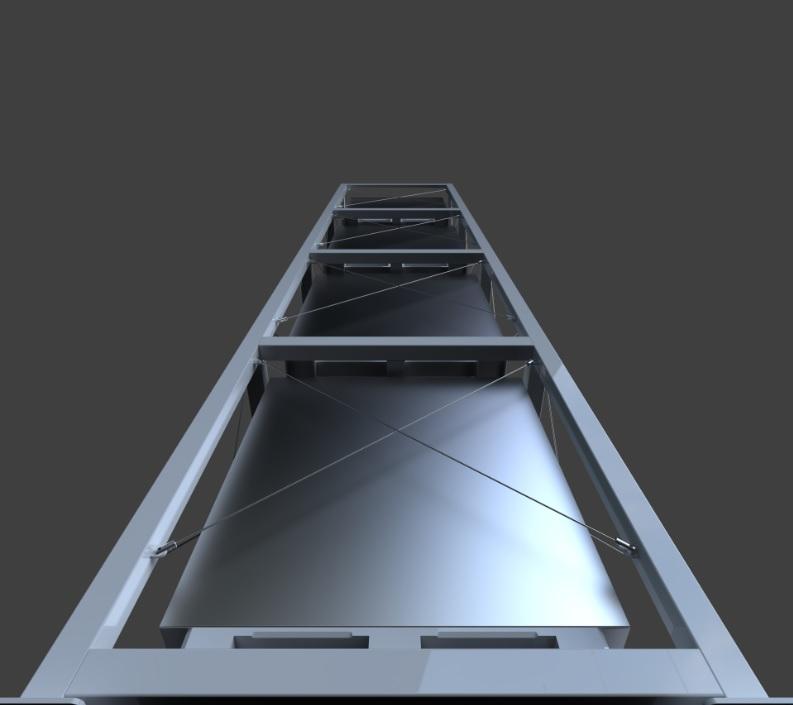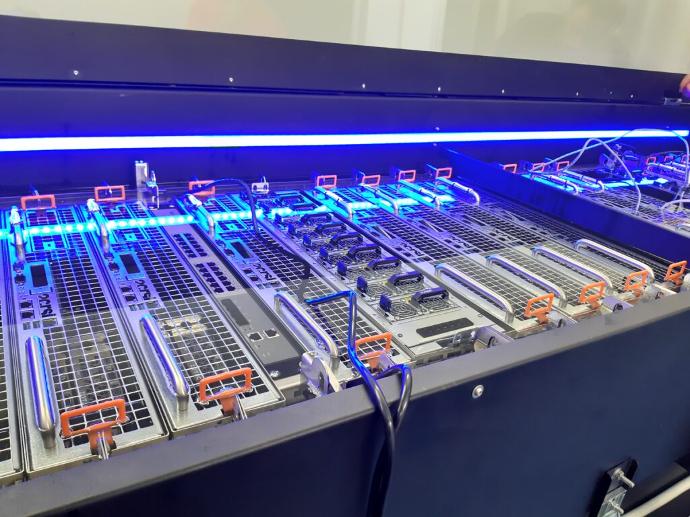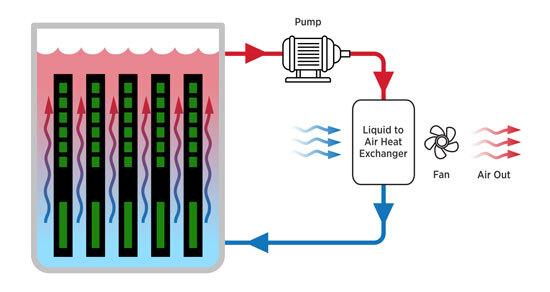The unrivalled Benefits.
Sodium-ion Immersion cooling, we are entering a new era for sustainable industry energy storage. Floor space less than 2m2. The packs are insulated and thermal stabilized, this allows an overall yield of more than 99%, Thermal Energy is "entirely" recycled and available.
Industry Energy Storage that make sense.
Sustainable technologies. We are solving the challenges of today and powering the use cases of the future. Immersion cooling has a huge number of benefits, especially when it comes to sustainability and efficiency. It significantly reduces the levels of carbon emissions, and much more.
AMOOVO MEGAWATT TOWER,
Revolutionizing Electricity Storage with Immersion Cooling**
Electricity storage is a key component in the transition to renewable energy sources and reducing greenhouse gas emissions. In this quest, the AMOOVO tower emerges as an innovative and comprehensive solution to meet large-scale electricity storage needs. It combines impressive storage capacity with an immersion cooling system, making it an exceptional option. Here are some of its key advantages.
1. **Impressive Storage Capacity**: The AMOOVO tower offers a storage capacity of 1 megawatt, allowing it to store substantial amounts of electricity. It can meet the growing demand for energy, thus helping to reduce electricity losses during transmission.
2. **Immersion Cooling**: Thanks to the immersion cooling of the cells, each tower compartment is isothermal, effectively preventing cell overheating. This allows the AMOOVO tower to withstand varying environmental conditions, including high temperatures, while maintaining optimal performance.
3. **Operational Versatility**: The AMOOVO tower can be used in a versatile manner, whether for storing intermittent solar or wind energy, stabilizing the electrical grid, or providing backup power during outages. Its versatility enhances grid reliability.
4. **Environmental Sustainability**: The design of the AMOOVO tower is environmentally friendly, with efficient cooling to prevent overheating and reduce environmental impact. It contributes to carbon emission reduction and preserves air quality.
5. **Low Operating Costs**: The simplicity of the AMOOVO tower's design translates into affordable operating costs. This makes it an economically viable option for businesses and electrical grid operators.
6. **Compact Footprint**: The AMOOVO tower's impressive 1-megawatt capacity is accompanied by a remarkably compact footprint, occupying less than 1.5 square meters (approximately 16 square feet) of ground space.
7. **Longevity and Durability with Stainless Steel Construction**: The robustness of the AMOOVO tower is further enhanced by the fact that its storage compartments are constructed from stainless steel. This stainless steel construction, not only ensures a long operational life, but also, adds durability by enhancing resistance to corrosion and wear. This feature makes the AMOOVO tower even more reliable for long-term investors.
8. **Energy Resilience**: By reliably storing large quantities of electricity, the AMOOVO tower enhances the resilience of energy infrastructure in the face of natural disasters or emergency situations. It can provide a stable energy source when other sources are unavailable.
Conclusion, the AMOOVO tower represents the future of electricity storage, combining exceptional capacity, immersion cooling, operational versatility, environmental sustainability, affordable operating costs, longevity, and a contribution to energy resilience. Its compact footprint makes it an ideal choice for locations with limited space. It is a comprehensive and efficient solution to meet the growing demand for electricity storage in today's world, while also contributing to the transition to cleaner and more reliable energy sources.

100% Safe & Easy to install
Our Technologies Guarantee the complete safety of Energy equipment. System deployment is as easy as assembling a LEGO Kit.
Open & Flexible
Our Tower Racks are User configurable. The Set of Plug & Play components allows installing liquid cooling as every other Energy Storage subsystem.
Compatible with all Inverters
Full support & guidance for every available system. Open system compatible with all platforms.
AMOOVO Goal
AMOOVO Team dreamed to integrate several, technologies. Our goal is to stay ahead of the curve with innovative technology solutions. How do we do this? From forming stronger partnerships with software and hardware industry leaders to hiring industry experts to consult and advise on solutions that will look to the future and anticipate the needs of our partners and customers.
What is immersion cooling?
AMOOVO developed an immersive isothermal battery technology whose main advantage is temperature constant maintenance. Simply put, immersion cooling is a method adopted by data centers to quickly cool IT hardware by directly immersing it in a non-conducive liquid. The heat that is generated from the components used is then directly and efficiently transferred to the liquid. It offers the highest level of efficiency plus virtually unlimited capacity.
Future-proofing Industry
Energy Storage aren’t going anywhere. Energy Storage demands are increasing. We are seeing continual changes in reach density, in both heat and power, to keep up with high performanceEnergy Storage trends, which include Artificial Intelligence, Automation, and Machine Learning. The current solutions can only sustain the power requirements, heating production increase, and future flexibility for so long.
Where we are now..
As with anything, the only constant is change. So, in order to ensure we continue to meet the needs of the industry and keep true to our core values, challenging the way we understand Energy Storage today and how this can create deep change in the way technology and humans behave, we have decided to broaden our scope and focus on three principal areas. Of course, while staying committed to providing solutions that make sense and ensure our customers have access to the most intuitive technology.
These three main areas can be explained as follows:
AMOOVO Cool's
Where it all began. Powered by our active single-phase Immersion Cooling, we have a range of modular solutions that empower users to effortlessly scale their operations while simultaneously saving space and energy and increasing Energy Storage capacity.
AMOOVO Scales
Designed as a turnkey solution that allows you to have a fully integrated, plug and play Energy Storage Battery. Flexible and agnostic, users can create a Energy Storage room, tailor-made to their specific needs. Take your infrastructure to the next level with easily intergratable robotics to maximize automation and propel your organization into the future.
AMOOVO Lab's
Created to ensure we are always evolving to meet the changing needs of society and the businesses which power it. With a broad range of expertise including thermodynamics, engineering, chemical engineering and much more, we are well-positioned to design the technology of the future and achieve our mission. Here we examine every element of Energy Storage infrastructure including power, energy and memory.
So, where are we going and what does this mean for you?
For you the customer, it means that you have access to technology that covers all the aspects you need to create a Smart Energy Storage Room. Guaranteeing that you are futureproofing your infrastructure. Trust in AMOOVO to guide and provide you with the necessary engineering to compete in the world of today and tomorrow.
AMOOVO Solutions and datacenters
Solutions for all
At AMOOVO we understand that it can be difficult to decide what solution can work best for you, there are many elements that need to be considered: servers, nodes, capacity, just to name a few. So, we’ve done the hard work for you.
With the help of our esteemed partners, we have created what we believe is the ultimate solution.
With three different options available per industry, you can choose from a fully customizable solution built to your particular specifications or, a basic solution that incorporates AMOOVO's proprietary Immersion technology with different customizable elements, giving you the confidence that the solution you’ve chosen will be perfect for the job without the hassle.
Power the future with Immersion, today.
Our Solutions have been designed to maximize internal footprints and achieve industry-leading operational and energy efficiency through Immersion cooling. The solutions are powered by AMOOVO’s industry-leading Immersion technology which empowers users to have high-density Energy Storage Batteries environments while simultaneously reducing their impact on their environment and increasing levels of sustainability.
The cooling Technology for the coolest Ideas
Education and Research centers are two pillars in the evolution of a society. AMOOVO designs highly efficient energy solutions. Academy world achieve epic milestones. AMOOVO addresses the needs of Energy Storage applications with a technology that:
- Cools unprecedented Batteries by uncapping thermal design limitations
- Is easy to deploy, implement and maintain (thanks to its modular and compact design)
Education and Research are the cornerstones of society. Thanks to the benefits of AMOOVO's solution, you will be able to push the boundaries of your research even further and become a leader of sustainable innovation.
Single-Phase Immersion Cooling VS Two-Phase Immersion Cooling
At AMOOVO we use the single-phase Immersion Cooling technique. Both single and two-phase offer ease of location for Energy Storage and do not depend on traditional infrastructure. When it comes to maintenance, typically, the single-phase immersion cooling technique requires much less maintenance and are much easier to access and repair if any adjustments may be needed.

Single-Phase Immersion Cooling
In a single-phase immersion cooling, servers are submerged in a thermally conducive dielectric liquid or coolant, which is a much better heat conductor than air, water, or oil. The coolant itself never changes state. With the help of a heat exchanger, heat is transferred to a cooler water circuit. The technique guarantees little to no risk of the coolant evaporating.
- Lower TCO
- +40-years coolant life
- Simple and safe to use
- Low complexity
- More efficient
- No raised floors or chillers
- Ecofriendly
Two-Phase Immersion Cooling
Two-phase cooling servers are also submerged in the same coolant, heat is removed differently. With a low boiling point (50°C), the fluid boils and rising vapor takes care of the heat transfer. All circulation happens passively and naturally.
- Extremely Expensive liquid (>$90/L)
- Must be replenished every 2 years
- Not environmentally friendly
- Medium complexity
- Less safe to use
- Requires a lot more maintenance
- Can be Toxic and Non Ecofriendly

Immersion Thermal Recycling
It is simple to Recycle Energy from Batteries.

Is liquid cooling the future of Energy Storage?
Energy Storage operators are evaluating infrastructure cooling options in liquid form in order to provide new, more efficient solutions to the new needs linked to the sustainability of our world.
Estimated at $3.14 billion in 2022, the worldwide liquid cooling market in data centers is expected to reach $31.7 billion in 2032, with annual growth of 25.8%.
Air cooling systems, the most commonly used in Energy Storage rooms today, are now showing their limits. They simply cannot cool high-density racks effectively and sustainably.
Long proven for mainframe Energy Storage, liquid cooling is expanding to protect rack-mounted Batteres around the world.
Let’s first see what liquid cooling is, what are the different technologies used for liquid cooling and what are its current advantages.
What is liquid cooling and what are its benefits?
As early as 1985, supercomputers were immersed in liquid for more efficient cooling. Today, the possibility of cooling CPUs and GPUs using liquid has made its way into many data centers.
Water and other liquids used are much more efficient than air at transferring heat and can help solve some of the problems with air-cooled systems, especially as compute densities increase.
The
main
liquid cooling
technologies
A liquid cooling technology that is gaining popularity is direct plate cooling. In this configuration, a cold plate is placed directly next to a component, such as a CPU, GPU, or memory card. Small tubes are connected to the plate to bring cold water and evacuate hot water. The hot water is then cooled so that it can be reused and circulated back to the cooling device.
A similar concept can be applied at the rack or server level. Water or another type of coolant circulates in a closed circuit system to carry out the heat exchange. Although the exact process varies from solution to solution, this solution generally uses a contained coolant, a heat exchanger to dissipate heat, and a mechanism to lower the temperature of the coolant as it circulates. For example, a heat exchanger can be mounted at the rear of the rack with fans on the opposite side to circulate air and dissipate heat. Another system thus routes the coolant underground to provide geothermal cooling.
Immersion cooling is a newer technology that is making great strides over time. With this approach, all internal components of the server are immersed in a non-conductive dialectical fluid. The components and fluid are then enclosed in a sealed container to prevent leakage. In this way, the heat from the components is transferred to the coolant which is circulated and cooled to continuously dissipate the heat.
The
advantages
of
liquid cooling
Liquid cooling-based technologies take advantage of the superior heat transfer properties of water or other fluids used to provide efficient and cost-effective cooling of high-density racks. This technology can be up to 3,000 times more efficient than using air.
Because liquid cooling conducts heat better than air, it can more effectively handle increasing data center densities, accommodating compute-intensive applications and arrays.
Additionally, liquid cooling significantly reduces power consumption and uses less water than many air-cooling systems, which can result in lower operating costs and a lower data center carbon footprint.
Finally, liquid cooling is also less bulky and less noisy.
Disadvantages
of liquid cooling
Despite all the advantages mentioned above, liquid cooling has a number of disadvantages. In addition to a higher capital cost, this technology requires data center administrators to learn new skills and adopt a new management framework, which can be a lot of work.
It may also be necessary to recruit additional staff or consultants who are familiar with this new technology and thus reduce the financial advantage in terms of return on investment. Additionally, the liquid cooling market is still maturing with a wide range of technologies resulting in proprietary products and risk of vendor lock-in.
What
factors to consider
when choosing between an
air-cooled and liquid-cooled
system
Companies building new Energy Storage Rooms or retrofitting existing Energy Storage Room may wonder if it's the right time to deploy liquid cooling now. Air cooling on the other hand is a safe bet that has already done time and time again its proofs.
Here are a number of factors to consider in making the best choice:
The
price
Cost will no doubt be one of the deciding factors, but achieving true total cost of ownership can be a complex process. Although liquid cooling comes with a higher capital cost, its greater efficiency can translate into lower operating costs, especially as densities increase. Additionally, liquid cooling uses less energy and consumes less water, which can be especially important in regions where water is scarce. On the other hand, the risk of vendor lock-in can impact the long-term total cost of ownership and maintenance.
The Batteries themselves should also be considered when evaluating the systems and total cost. Liquid cooling helps support higher Batteries densities while reducing the carbon footprint of the data center, resulting in better space utilization and lower costs.
Ease
of installation &
maintenance
Another important consideration is the deployment and maintenance of the liquid cooling system. With air cooling, equipment operation and component replacement are usually straightforward. That's not to say that air cooling doesn't come with its own set of challenges, such as ongoing water treatment or mechanical maintenance, but it's a known entity with a long history to take all of them into consideration. these elements.
Liquid cooling represents a new mindset and a new way of working. Energy teams and Energy Storage Rooms will face a steep learning curve, and in some cases may be dependent on a vendor for routine maintenance. When analyzing costs, data center operators should evaluate all the implications of deploying and maintaining a cooling system.
Efficiency
Some Energy Storage rooms do not support high Batteries processing density, so a move to liquid cooling may not be justified. That said, Energy Storagendensities are only going to increase in the years to come. Energy Storage Batteries are striving to make better use of usable floor space, and R&D departments are consolidating workloads to improve efficiency. At some point, liquid cooling might become the only viable option, but that doesn't mean Energy Storage Batteries have to make the switch right away.
Other efficiency considerations can play a role in choosing liquid cooling over air cooling. For example, a Energy Storage Room operator may be moving towards greener practices and want to adopt technologies such as liquid cooling which uses fewer resources and is much quieter.
The location of the Energy Storage Room can also be an important selection criterion. A Energy Storage Roome located near the Arctic may use an abundance of cold air, while a Energy Storage Room located in hot areas will have difficulty maintaining air cooling systems over the long term.
A Energy Storage Room located in a crowded urban environment may need to increase the Batteries density of its racks to maximize floor space. Local regulations, tax benefits or other similar issues may also play a role.
Today, with air cooling, companies know what they're getting into, but its long-term usefulness might be limited. Companies that don't need to rush to make a decision might want to give liquid cooling more time to mature.
One thing is certain, this technology should continue to grow and mature over time, whether to meet the needs of more efficient cooling systems or to reduce the carbon footprint of their Energy Storage Rooms.